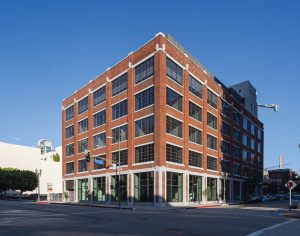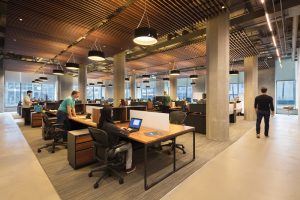Skidmore, Owings & Merrill LLP was an Outstanding Award winner for The Desmond Building project in the 2017 Annual Excellence in Structural Engineering Awards Program in the Category – Forensic/Renovation/Retrofit/Rehabilitation Structures under $20M.
Located in downtown Los Angeles’ rising South Park commercial district, The Desmond Building has recently been infused with new life through a full renovation, expansion, and seismic retrofit. Before the renovation and seismic retrofit, independent research had identified the Desmond as one of Los Angeles’ many existing seismically vulnerable, non-ductile concrete buildings at risk of being significantly damaged in the next major earthquake. Mayor Eric Garcetti of Los Angeles, in December 2014, issued his Resilience by Design initiative – introducing guidelines that require all vulnerable non-ductile concrete buildings in LA to undergo a seismic retrofit. The Desmond exemplifies how similar historic properties can be innovatively renovated to include additions without exceeding code retrofit triggers.
Designed in 1916, the building was initially a Willys-Overland car dealership and assembly plant, which later became a Desmond’s department store warehouse. The building stood mainly empty for many years before finally being purchased by a prominent development company in 2013 to renovate for high-end creative office use.
The existing five-story-tall concrete structure, approximately 100 x 157 feet, consisted of columns framed by shallow girders and two-way flat slabs. The columns and beams constituted non-ductile moment frames in two directions. Existing condition surveys classified the structure as in very good condition. Fortuitously, good quality original drawings were also made available to the design team.
Because of the low original design material strengths, and the proposal to add a story to the building, stringent criteria were established through in-depth discussions with the Los Angeles Department of Building and Safety (LADBS).
To meet these criteria, the project team devised a solution in which the sixth-floor addition was made as light as possible, coupled with resourcefully reducing seismic weight throughout the building. Multiple two-way steel special moment frames were provided for the addition, with columns centered on columns below to uniformly distribute and balance the seismic loading effects. A lightweight roof system and exterior cladding were used. Mechanical system equipment was distributed over the height of the building rather than concentrated on the roof (as is typical). New lightweight architectural finishes were used throughout the building. As a result of controlling weight, the need for a seismic retrofit was not triggered per code. A complete seismic retrofit was nevertheless provided.
The internal structure supporting gravity loads – floor framing, columns, and foundations – was originally designed to support a live load of 100 psf on all floors including the roof. Changing to office usage with a live load of 50 psf (reducible) allowed the addition of the new floor without triggering the need for retrofit of the gravity load supporting members. Additional measures were taken to minimize the loading on individual members. Existing stair and elevator openings were re-used, and cast-in-place concrete stairs were replaced with lighter steel stairs. New openings for MEP systems were minimal and unnecessary existing weight was removed. Controlling weight to avoid triggering a retrofit was so fine-tuned that an inch of architectural concrete topping was removed at two floor levels.
Even though the loads were controlled so that a retrofit was shown not to be required by code, the owner desired to assure tenants that the structure was safe and designed to resist the same seismic forces as a new building under current codes. An internal perimeter retrofit was developed to mimic the original industrial look in a non-intrusive manner, using new concrete wall piers and upturned link beams to envelop the perimeter on three sides. Exterior brick façades were restored and anchored to the new pier and link beam framing structure, maintaining the exterior appearance. Unobstructed multi-lite steel windows were refurbished.
Along the solid north wall, two single bay long shear wall piers were provided and linked to the diaphragms using steel collector beams. At the base of all the new piers on the other three sides of the building, an interconnected foundation system of grade beams and new footings was provided. Lastly, composite fiber wrap confinement was provided at the ends of all internal gravity columns to meet deformation compatibility requirements.
The rigorous, code-prescriptive retrofit solution enabled the addition of income-generating space while preserving the historic character of the century-old building. This resulted in the project developers finding a tenant for the entire building, well before construction was complete, who ended up buying the building upon its completion. This renovation and retrofit project successfully improved the street appeal of the building and increased The Desmond’s total square footage from 75,000 square feet to 82,000 square feet. The Desmond’s structural solution exemplifies how many other non-ductile historic properties in Los Angeles can be safely and sustainably renovated for creative office use – to preserve each neighborhood’s culture and history while still adding more “Class A” spaces with appropriate structural resiliency.▪


